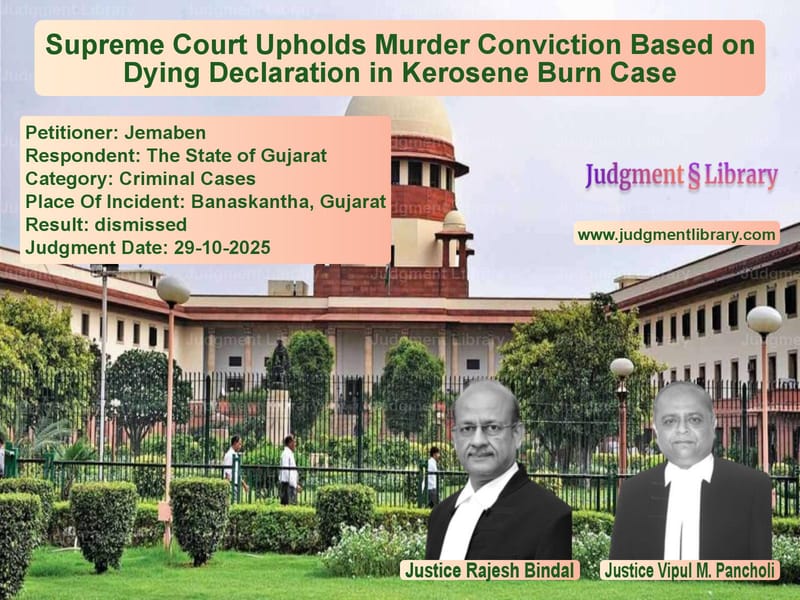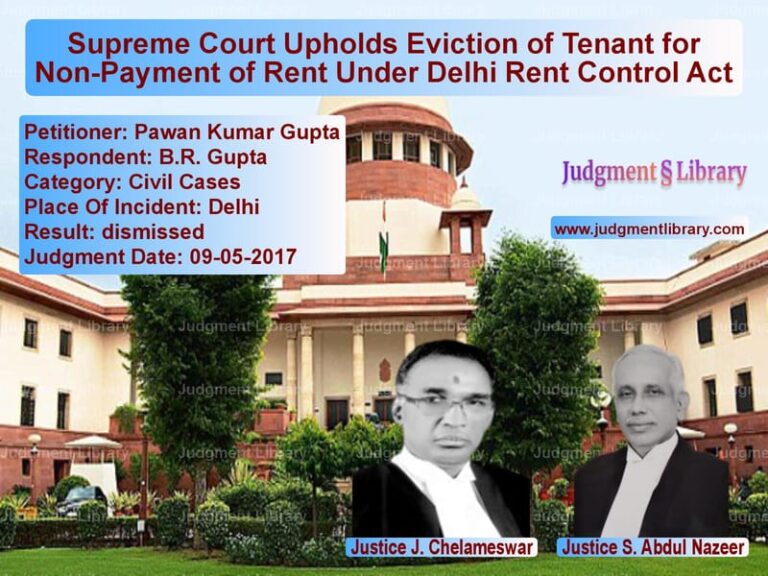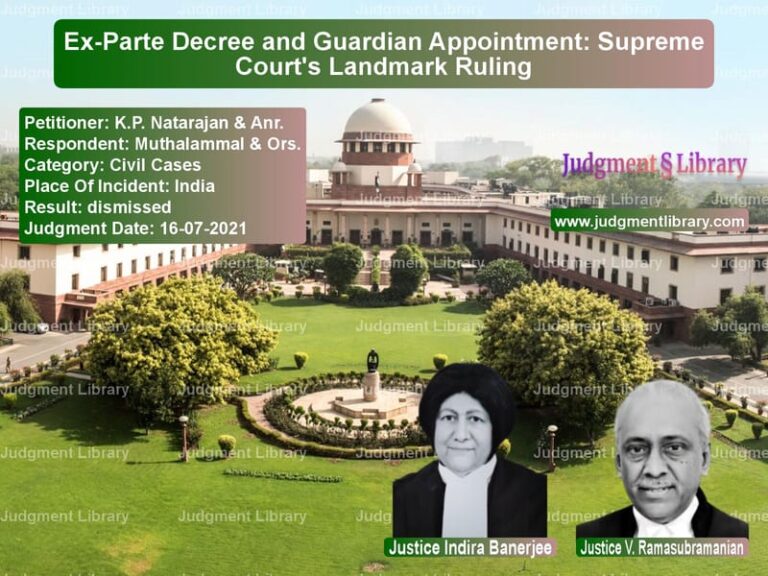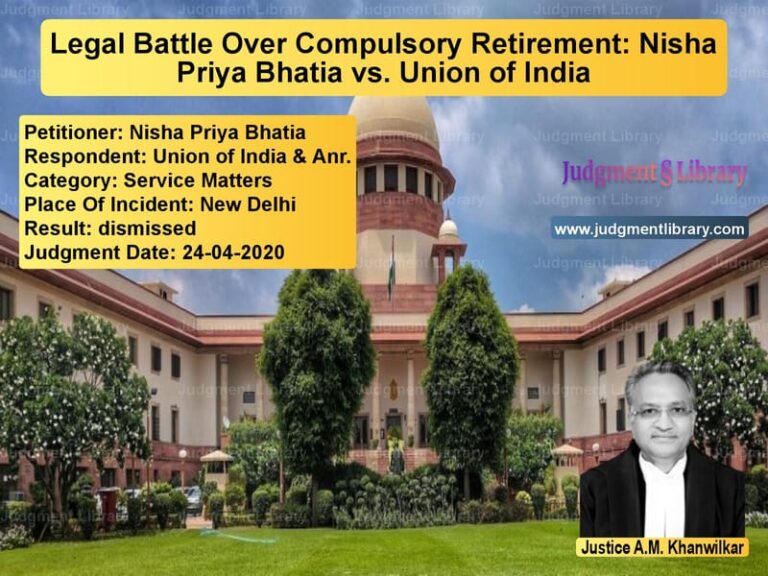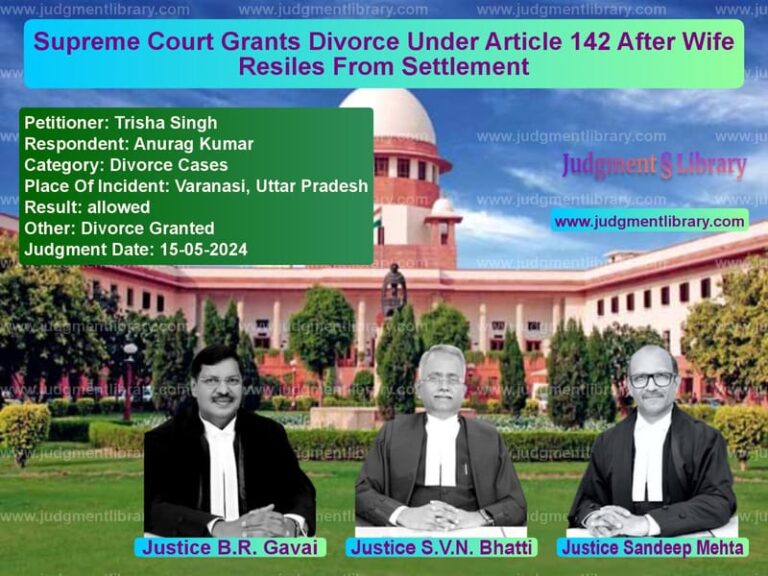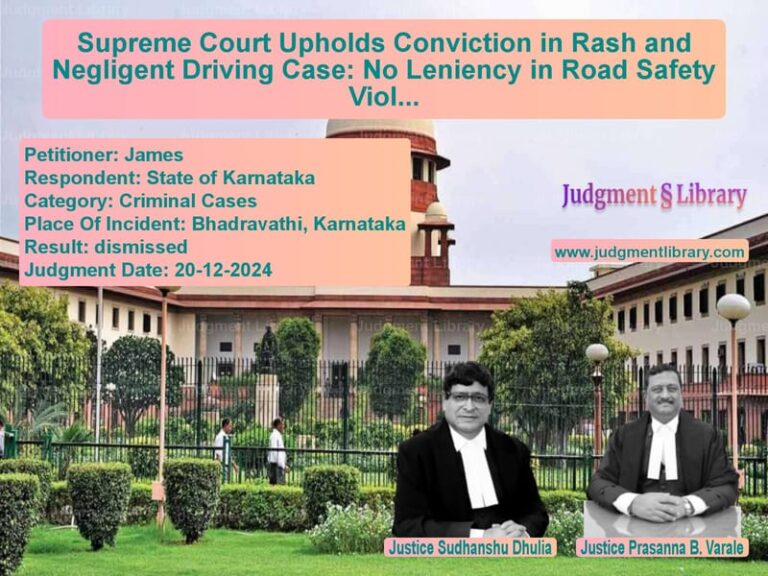Supreme Court Upholds Murder Conviction Based on Dying Declaration in Kerosene Burn Case
In a significant ruling that reinforces the evidentiary value of dying declarations in criminal cases, the Supreme Court of India has upheld the murder conviction of Jemaben for the brutal killing of her aunt-in-law Leelaben by setting her on fire with kerosene. The judgment, delivered on October 29, 2025, provides crucial clarity on how courts should evaluate multiple dying declarations and the circumstances surrounding such statements when they become the primary evidence in homicide cases.
The tragic incident dates back to the intervening night of November 29-30, 2004, in Banaskantha, Gujarat, when Leelaben and her four-year-old son Ganesh were sleeping in their hut. According to the prosecution, Jemaben poured kerosene on Leelaben and set her ablaze, resulting in Leelaben sustaining severe burn injuries that eventually proved fatal on December 4, 2004. The young boy also suffered 10-12% burn injuries on his lower legs and feet during the same incident.
The case took several legal turns before reaching the Supreme Court. The trial court had initially acquitted both accused persons, including Jemaben, mainly on the ground that there were discrepancies in the three dying declarations given by Leelaben. However, the Gujarat High Court later overturned this acquittal and convicted Jemaben under Section 302 of the Indian Penal Code for murder, sentencing her to life imprisonment. It was this High Court judgment that Jemaben challenged before the Supreme Court.
The Legal Arguments
Jemaben’s counsel presented several arguments challenging the conviction: ‘Learned Counsel appearing for the appellant/accused mainly contended that the case of the prosecution rests primarily on the dying declaration given by the deceased. However, there are major discrepancies in the story put forward by the prosecution. In fact, version of the complainant (PW-1), Kaluhhai Lakhuji (PW-4, husband of Leelaben), as well as other documentary evidence contain major discrepancies, inconsistencies and material contradictions. Thus, the trial court has rightly acquitted the appellant/accused, despite which, the High Court has, substantially relied upon the deposition given by Dr. Shivramh hai Nagarh hai Patel, (PW-3, Incharge Medical Officer) as well as relied upon the Yadi given by the said Doctor to the Police, which mentioned the history given by the deceased before the said witness, and thereby recorded the order of conviction of the appellant/accused.’
The defense further argued that when two views are possible based on the evidence, the trial court’s view favoring acquittal should not have been disturbed: ‘Therefore, even if there are two views possible on the basis of the evidence led by the prosecution before the trial court, when the trial court has taken the one possible view, the High Court ought not to have interfered with the said view taken by the trial court.’
The State of Gujarat, represented by its counsel, vehemently defended the conviction: ‘Per contra, learned counsel appearing for the respondent-state has vehemently opposed the present appeal. Learned Counsel for the State mainly submitted that, in the case of multiple dying declarations, each dying declaration will have to be considered independently on its own merit as to its evidentiary value and one cannot be rejected because of the contents of the other.’
The prosecution emphasized the significance of the first dying declaration recorded by the doctor: ‘It is submitted that in the present case, even though the dying declaration has not been recorded by the Executive Magistrate, it is clear from the medical certificate issued by PW-3, that the statement of the deceased, recorded first in point of time, reveals that the deceased was burnt by the appellant/accused, who was the aunt-in-law of the deceased, by pouring kerosene from the tin and setting the deceased on fire.’
The State also revealed the motive behind the crime: ‘On the very same day, the deceased described the motive behind the incident that the appellant/accused was compelling the deceased to go with one, Mania Dabhawala, with whom the appellant/accused was acquainted and refusal by the deceased thereto, resulted into the incident in question.’
The Supreme Court’s Analysis
The Supreme Court, after carefully examining the evidence and arguments, delivered a comprehensive judgment upholding the conviction. The Court placed significant weight on the first dying declaration made to Dr. Shivramh hai Nagarh hai Patel (PW-3): ‘It emerged from the record that when the deceased was brought to the hospital, she narrated the incident before the Doctor (PW-3) wherein she specifically stated that “my aunt-in-law, Jemaben poured kerosene on me and set ablaze.” Further, when she was asked again by the doctor, she disclosed that “my aunt-in-law asked me to go with Mania Dabhawala, I refused for the same and, therefore, she burnt me alive”.’
The Court noted the doctor’s certification about the victim’s condition: ‘It is also specifically stated by the Doctor in the said Yadi that the patient was conscious and she was in a position to speak. Therefore, the said police officer was asked to make arrangements for recording the dying declaration of the deceased.’
The medical evidence provided crucial corroboration: ‘At this stage, it is also relevant to observe that the Medical Certificate of the deceased also states that the “whole body and clothing having kerosene smelling burns about 100%”.’
Physical Evidence Corroboration
The Court found compelling physical evidence that supported the dying declaration: ‘From the panchnama, it further transpires that investigating agency found “one empty container having kerosene smell” from the place of incident. Similarly, the soil of the surface of the hut (the place of incident) was having smell of kerosene. Thus, the aforesaid document also corroborates the version given by the deceased before the independent witness, i.e. PW-3, the Doctor.’
The Court also noted the significance of the burn injury pattern: ‘At this stage, it is also relevant to observe that PW-3 deposed before the court that the son of the deceased, aged about 4 years, was brought before him by the relatives of the deceased and when inquired they told that the said boy sustained burn injuries along with his mother. It is further stated by the said witness that the said boy sustained 10-12% burn injuries on his lower legs and feet.’
This pattern of injuries became a crucial factor in rejecting the possibility of an accidental fire: ‘On perusal, it is clear that the deceased sustained 100% burn injuries and from the whole body and the clothes of the deceased, the smell of kerosene was found. However, the 4 years old son of the deceased was sleeping beside the deceased and he sustained only 10-12% burn injuries. Thus, the theory of accidental fire at the place of incident put forward by the appellant/accused cannot be believed.’
Evaluation of Multiple Dying Declarations
The Supreme Court addressed the core issue of how to evaluate multiple dying declarations that might contain discrepancies: ‘We are of the view that merely because there are minor discrepancies in the version given by the prosecution witness with regard to the dying declaration and with regard to the manner of occurrence of the incident, the first dying declaration given by the deceased before the independent witness, i.e PW-3, cannot be ignored.’
The Court emphasized that the first dying declaration was supported by independent documentary evidence and therefore deserved greater weight: ‘The first dying declaration is supported by the independent documentary evidence, and therefore, the High Court has rightly placed reliance upon the decision rendered by this Court in the case of Nallam Veera Stayanandam & Ors. v. Public Prosecutor, High Court of A.P., (2004) 10 SCC 769, and thereby, rightly set aside the order of acquittal rendered by the trial court qua the appellant/accused.’
Final Ruling
The Supreme Court concluded that only one reasonable view was possible based on the evidence, and the trial court had erred in acquitting the accused: ‘We are also of the view that on the basis of the aforesaid evidence as discussed hereinabove, only one view was possible, despite which, the trial court had acquitted the appellant/accused. Thus, the High Court has rightly set aside the order of the trial court.’
In its final analysis, the Court stated: ‘In view of the aforesaid facts and circumstances of the present case set out in the detailed analysis above, we are of the view that no interference is required in the impugned judgment passed by the High Court in Criminal Appeal Number 539 of 2006. Accordingly, the present appeal stands dismissed.’
This judgment serves as an important precedent in criminal jurisprudence, particularly regarding the evaluation of dying declarations. The Supreme Court’s ruling reinforces that minor discrepancies in multiple dying declarations should not automatically discredit such evidence, especially when the first declaration is made to an independent witness like a doctor, is corroborated by physical evidence, and the victim’s condition at the time of making the statement is properly certified. The Court’s approach demonstrates a balanced consideration of both the sanctity accorded to dying declarations in law and the need for corroborative evidence to ensure justice.
Petitioner Name: Jemaben.Respondent Name: The State of Gujarat.Judgment By: Justice Rajesh Bindal, Justice Vipul M. Pancholi.Place Of Incident: Banaskantha, Gujarat.Judgment Date: 29-10-2025.Result: dismissed.
Don’t miss out on the full details! Download the complete judgment in PDF format below and gain valuable insights instantly!
Download Judgment: jemaben-vs-the-state-of-gujarat-supreme-court-of-india-judgment-dated-29-10-2025.pdf
Directly Download Judgment: Directly download this Judgment
See all petitions in Murder Cases
See all petitions in Judgment by Rajesh Bindal
See all petitions in Judgment by Vipul M. Pancholi
See all petitions in dismissed
See all petitions in supreme court of India judgments October 2025
See all petitions in 2025 judgments
See all posts in Criminal Cases Category
See all allowed petitions in Criminal Cases Category
See all Dismissed petitions in Criminal Cases Category
See all partially allowed petitions in Criminal Cases Category

